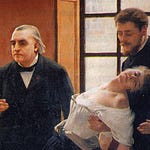Image from Tickled (2016).
Aristotle was concerned about tickling. In Parts of Animals, he wrote that human beings were the only creatures that were susceptible to tickling, due to ‘the fineness of their skin’ and ‘being the only creatures that laugh.’1 Tickling is, for Aristotle, a uniquely human endeavour and a uniquely human pursuit of pleasure.
While Aristotle’s claim that only humans were susceptible to tickling has been debunked - research has shown apes and other primates can be tickled, as well as rats - tickling between adult humans is still regarded as, at best, slightly unorthodox.2 The few non-weird situations adults can tickle each other in are usually confined to intimate moments of teasing between lovers. If a casual acquaintance began to tickle you over coffee, you’d (rightly) think they were bizarre and probably not see them again.
Tickling porn, however, is a booming genre. A quick search for ‘tickling’ on PornHub brings up over two thousand results of people being variously pinned down, tied up, or otherwise restrained while their tickle tormentor goes to town. When researching this entry, several friends asked if I’d seen the 2016 documentary Tickled, about a US-based tickle porn empire that bribed hundreds of teenage boys into participating. A Google search for ‘tickle porn’ came back with 55 million results. Tickle porn is thriving.
The tropes of tickle porn are fairly regimented: one participant is usually tied down on a flat surface with their hands above their head, leaving their ticklish flanks and armpits exposed. The other participant will stand over them or straddle them and begin to tickle their stomach and sides. It’s often a one-on-one endeavour, but gang-bang style ticklings are also popular, where one victim is restrained and surrounded by three or more ticklers.
As the porn begins in earnest, the ticklee will begin to struggle against their restraints, their laughter becoming more strained and sometimes punctuated with ‘no’ and ‘stop’. The performative lack of consent is part of the game, where the ticklee’s smile and laughter contrasts against their protestations. The tickler will tease them, often mocking their lack of resilience or toughness, their ability to be reduced to a writhing, laughing mess simply through the movement of their fingers.
Why does tickling, for those who create and consumed tickle porn, register as sexual and erotic, when in most of the tickle porn videos there is no genital touching? This wouldn’t be a sex newsletter if Freud wasn’t invoked at some point, and indeed Freud does mention tickling as part of psychosexual development. In Three Contributions to the Theory of Sex, Freud writes on the development of infantile awareness of erongenous zones that ‘rhythmic characters must play some part in them, and this strongly suggests an analogy to tickling.’3 Freud gestures to but does not fully commit to tickling being a precursor to the rhythmic movement of masturbation.
Detail from The Tickle by Pietro Longhi (1755).
While we must always take Freud with a hefty pinch of salt, there is something to be said for tickling fetishes originating in childhood play. Lawrence Cohen, a doctor of play and parenting, states that ‘tickling can overwhelm the nervous system and make children feel helpless and out of control. The reflexive behaviour can disguise discomfort, and even pain.’4 Similarly, Alan Fridlund, a doctor of nonverbal communication, writes that ‘the smile is a play face, but the grimace, a submissive threat face, looks similar, and that’s what you see when tickling turns into something unwanted.’5
‘Extreme tickling,’ Fridlund continues, ‘can also induce something known as “cataplexy”, a sudden, temporary loss of muscle control or paralysis.’ A sudden loss of muscle control after a prolonged, rhythmic build of touching sounds suspiciously like an orgasm. In play between adults and children, tickling is not necessarily sexual in nature, but does involve close bodily contact and a sense of powerlessness that can easily be mapped onto fetishisation of bodies and power in later life, especially if accompanied by a cataplexy.
The constant oscillation between pleasure and pain, desire and revulsion is at the heart of tickle porn. The laughter of the ticklee gives a social signal of enjoyment even while the smile dips into a grimace of pain and distress. One study found that when surgeons cut pain fibers in the spinal cord for treatment of chronic pain, responsiveness to tickling was significantly reduced.6 Pain and pleasure meet in tickling. The childhood experience of ‘tickle torture’ - being pinned down and tickled until tears - is a formative experience in intimate touch directed at erogenous zones that will, in later life, be primary sites of sexual pleasure. Tickling becomes intertwined with pleasurable loss of control, the stimulation of erogenous zones, and an interplay between laughter and pain.
Aaron Shuster writes in ‘A Philosophy of Tickling’ that ‘Perhaps tickling is between internal and external, blurring boundaries of internal sensation and external stimuli between pain and itch and pleasure.’7 Our formative experiences of other people’s bodies, and their ability to control our bodies, is found in childhood tickling. The inside and outside meet in the tickle, and we lose ourselves to the sensation. Whether we like it or not, we’re all vulnerable to being tickled, to losing control, to achieving an orgasmic cataplexy - it is this universal vulnerability that tickle porn turns erotic.
Robin Craig is a PhD student and freelance cultural writer. You can find him on Twitter at @robin__craig.
Aristotle, Parts of Animals, III, x, 673a2–8, trans. A. L. Peck (Cambridge, MA: Harvard University Press, 1937), p. 281.
Jaak Panksepp and Jeff Burgdorf, “‘Laughing’ Rats and the Evolutionary Antecedents of Human Joy?,” Physiology & Behavior, vol. 79 (2003), pp. 533–547.
Sigmund Freud, Three Contributions to the Theory of Sex, vol. 2 (1916).
Lawrence Cohen, quoted by Jenny Marder, NYTimes (13/07/2020), ‘The Case Against Tickling’.
Alan Fridlund, ibid.
Lahuerta et al., 1990, cited in Christine R. Harris, ‘The mystery of ticklish laughter’, American Scientist, 1999.
Aaron Shuster, Cabinet Magazine (2013), ‘A Philosophy of Tickling: A Sensation Between Physics and Metaphysics’.












